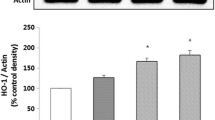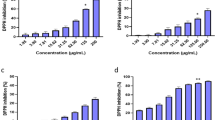Abstract
The present study reports cytoprotective and antioxidant activity of aqueous and alcoholic extracts of Rhodiola imbricata rhizome on tert-butyl hydroperoxide (tert-BHP) induced cytotoxicity in U-937 human macrophages. There was an increase in cytotoxicity and apoptosis significantly in the presence of tert-BHP over control cells. The tert-BHP induced cytotoxicity can be attributed to enhanced reactive oxygen species (ROS) production which in turn is responsible for fall in reduced glutathione (GSH) levels; further there was a significant decrease in mitochondrial potential and increase in apoptosis and DNA fragmentation. Both aqueous and alcoholic extracts of Rhodiola rhizome at a concentration of 250 μg/ml were found to inhibit tert-BHP induced free radical production, apoptosis and to restore the anti-oxidant levels to that of the control cells. The alcoholic extract of Rhodiola showed higher cytoprotective activities than aqueous extract. These observations suggest that the alcoholic and aqueous extracts of Rhodiola have marked cytoprotective and antioxidant activities.
Similar content being viewed by others
References
Eastwood MA: Interaction of dietary antioxidants in vivo: How fruits and vegetables present disease? QJM 92: 527–530, 1999
Siddique MS, Eddeb F, Mantle D, Mendelow AD: Extracts of Ginkgo biloba and Panax ginseng protect brain proteins from free radical induced oxidative damage in vitro. Acta Neurochirurgica Suppl 76: 87–90, 2000
Koleva II, Van Bleek TA, Linssen JP, De-Groot A, Evstatieva LN: Screening of plant extracts for antioxidant activity: A comparative study on three testing methods. Phytochem Anal 13: 8–17, 2002
Halliwell B: Antioxidants and human disease: A general introduction. Nutr Rev 55: s44–s52, 1997
Meydani SN, Wu D, Santos MS, Hayek MG: Antioxidants and immune response in aged persons: Overview of present evidence. Am J Clin Nutr 62: 1462S–1476S, 1995
Scartezzini P, Speroni E: Review on some plants of Indian traditional medicine with antioxidant activity. J Ethnopharmacol 71: 23–43, 2000
Tapiero H, Tew KD, Ba GN: Polyphenols: Do they play a role in the prevention of human pathologies? Biomed Pharmacother 56: 200–207, 2002
Mizue Ohsugi, Wenzhe Fan, Koji Hase, Quanbo Xiong, Yasuhiro Tezuka, Katsuko Komatsu, Tsuneo Namba, Tomhiro Saitoh, Kenji Tazawa, Shigetoshi Kadota: Active-oxygen scavenging activity of traditional nourishing-tonic herbal medicines and active constituents of Rhodiola sacra. J Ethnopharmacol 67: 111–119, 1999
Ming HQ, Xia GC, Zhang RD, Zhongcaoyao: Advanced research on Rhodiola. Chinese Herbal Medicines 19: 229–234, 1988
Darbinyan V, Kteyan A, Panossian A, Gabrielian E, Wikman G, Wagner H: Rhodiola rosea in stress induced fatigue: A double blind cross over study of a standardized extract SHR-5 with a repeated low dose regimen on the mental performance of healthy physicians during night duty. Phytomedicine 7(5): 365–371, 2000
Furmanova M, Skopinska-Rozewska E, Rogala E, Malgorzata H: Rhodiola rosea in vitro culture: Phytochemical analysis and antioxidant action. Acta Societis Botanicorum Poloniae 76(1): 69–73, 1998
Bolshakova IV, Lozovskaia EL, Sapezhinskii II: Antioxidant properties of a series of extracts from medicinal plants Biofzika 42(2): 480–483, 1997
Siu Po Ip, Chun Tao Che, Po Sing Leung: Association of free radicals and the tissue renin-Angiotensin system: Prospective effects of Rhodiola, a genus of Chinese herb, on hypoxia induced pancreatic injury. J Pancreas 2(1): 16–25, 2001
Peng JN, GE YC, Li XH: Studies on chemical constituents of Rhodiola fastigita. Acta Pharmacuet Sin 31: 798–800, 1996
Sairam M, Anju B, Pauline T, Prasad D, Kain AK, Mongia SS, Sharma SK, Singh B, Singh R, Ilavazhagan G, Kumar D, Selvamurthy W: Effect of Kombucha tea on chromate (VI) induced oxidative stress in albino rats. J Ethnopharmacol 71: 235–240, 2000
Cathcart R, Schwiers E, Ames BN: Detection of picomole levels of hydroperoxides using fluorescent dichlorofluorescein assay. Ann Biochem 134: 111–116, 1983
Hissin PJ, Hilf R: A fluorometric method for determination of oxidized and reduced glutathione in tissues. Ann Biochem 74: 214–226, 1976
Jiang T, Acosta D: An in vitro model of cyclosporin induced nephrotoxicity. Toxicol Appl Phamacol 20: 486–495, 1993
Tice RR, Andrews PW, Hirai O, Singh NP: The single cell gel (SCG) assay: An electrophoretic technique for the detection of DNA damage in individual cells. In: C.M. Witmer (ed.) Biological and Reactive Intermediates IV. Plenum Press, New York, 1990. pp. 157–164
Collins AR, Ai-guo M, Duthie SJ: The kinetics of oxidative DNA damage (strand breaks and oxidized pyrimidines) in human cells. Mutat Res 336: 69–77, 1995
Altman SA, Zastawny TH, Randers L, Lin Z, Lumpkin JA, Remacle J, Dizdaroglu M, Rao G: Tert-butyl hydroperoxide mediated DNA base damage in cultured mammalian cells. Mutat Res 306: 35–44, 1994
Baker M, He S: Elaboration of cellular DNA breaks by hydroperoxides. Free Radical Biol Med 11: 563–572, 1991
Dubuisson ML, De Wergifosse B, Trouet A, Baguet F, Marchand-Brynaert J, Rees JF: Antioxidative properties of natural coelenterazine and synthetic methyl coelenterazine and synthetic methyl coelenterazine in rat hepatocytes subjected to tert-butyl hydroperoxide induced oxidative stress. Biochem Pharmacol 60(4): 471–447, 2000
Suzuki Y, Apostolova MD, Cherian MG: Astrocyte cultures from transgenic mice to study the role of metallothionein in cytotoxicity of tert-butyl hydroperoxide. Toxicol 145: 51–62, 2000
Hongjintian In Zheng HZ, Dong ZH, She J: Modern study of traditional Chinese medicine. Vol 6, 1st edn, Beijing Xue Yuan press, Beijing, 1997, pp. 5658–5678
Ishige K, Schubert D, Sagara Y: Flavanoids protect neuronal cells from oxidative stress by three distinct mechanisms. Free Radical Biol Med 30(4): 433–446, 2001
Inhee Mook-Jung, Hee Kim, Wenzhe Fan, Yasuhiro Tezuka, Shigetoshi Kadota, Hisao Nishijo, Min Whan Jung: Neuroprotective effect of constituents of the oriental crude drugs, Rhodiola sacra, R. sachalinensis and Tokaku-joki-to, against Beta-amyloid toxicity, oxidative stress and apoptosis. Biol Pharm Bull 25(8): 1101–1104, 2002
Author information
Authors and Affiliations
Corresponding author
Rights and permissions
About this article
Cite this article
Kanupriya, Prasad, D., Ram, M.S. et al. Cytoprotective and antioxidant activity of Rhodiola imbricata against tert-butyl hydroperoxide induced oxidative injury in U-937 human macrophages. Mol Cell Biochem 275, 1–6 (2005). https://doi.org/10.1007/s11010-005-7637-1
Received:
Accepted:
Issue Date:
DOI: https://doi.org/10.1007/s11010-005-7637-1




